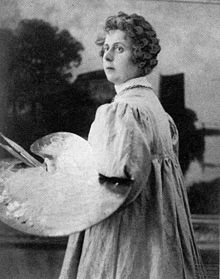Sophie Wencke-Meinken
Sophie Wencke-Meinken (born July 29, 1874 in Bremerhaven , † June 23, 1963 in Worpswede ) was a German painter.
biography
Sophie Wencke was the first daughter of shipyard owner Nicolaus Diedrich Wencke (* 1848) and granddaughter of shipyard entrepreneurs Friedrich Wilhelm Wencke and Gesine Wencke . In 1884 she named the first German fish steamer for the Friedrich Busse shipping company with the name Sagitta . She attended school in Bremerhaven and studied art painting in Dresden from 1891 to 1893 and in Berlin from 1893 to 1897 with painters such as the animal painter Hermann Pansee, the landscape painter Berta Schrader and in Berlin with the landscape painter Max Uth . In 1898 she took part in the launch of the passenger steamer Assyria in Bremerhaven . In the same year, when she was launched, one of her most famous paintings was created, which is now in the collection of the Historisches Museum Bremerhaven (Morgenstern Museum).
Since October 1898 she lived in Worpswede. In 1903 she was followed by her younger sister Clara. At first she was a student of Otto Modersohn and she painted landscapes. Since 1903 she has also created templates for postcards and art prints for the Seemann art publisher in Leipzig. Through a lively exhibition activity with well-known painters such as Fritz Overbeck , Otto Modersohn or Heinrich Vogeler , among others in Bremen, Berlin, Leipzig and Cologne , she became known primarily as a landscape painter in the Impressionist style. In 1910 she and her sister Clara moved into their own studio, which is now Café Central .
From 1916 the two sisters stayed in the porcelain town of Selb and created templates for the Hutschenreuther porcelain factory . After the First World War (1919) she married the Hamburg post director Dr. Wilhelm Meinken, now called himself Wencke-Meinken and lived in Hamburg-Bergedorf , but kept her studio in Worpswede.
Since 1933 she lived again in Worpswede and created watercolors and then oil paintings for a Weser cycle here. She fulfilled an assignment for the city of Remscheid . In World War II cityscapes originated from food . Her study trips took her to Italy , Scotland and the Sauerland, among others . She kept in touch with her hometown Bremerhaven and with the shipowners and shipyards and was artistically inspired.
Works (selection)
- Launched , oil painting, 1898, Historical Museum Bremerhaven
- Bursfelde Monastery
- Houses in the Teufelsmoor
- Hammeniederung , oil / canvas, Lilienthaler Kunststiftung
- Bouquet of flowers in the window , oil / canvas, Lilienthaler Kunststiftung
- Weser cycle , oil paintings, 1933/34
literature
- Anja Benscheidt, Alfred Kube: The landscape painter Sophie Wencke. From the Wencke shipyard in Bremerhaven to Worpswede. Historisches Museum Bremerhaven , Kleine Schriften 8, Wirtschaftsverlag NW, Bremerhaven 2008, ISBN 978-3-86509-832-0 .
- Anja Benscheidt: Wencke, Sophie . In: Frauen Geschichte (n) , Bremer Frauenmuseum (ed.). Edition Falkenberg, Bremen 2016, ISBN 978-3-95494-095-0 .
- Herbert Black Forest : The Great Bremen Lexicon . 2nd, updated, revised and expanded edition. Edition Temmen, Bremen 2003, ISBN 3-86108-693-X .
- Worpswede in all its diversity . Weser Kurier , 2011.
Web links
| personal data | |
|---|---|
| SURNAME | Wencke-Meinken, Sophie |
| ALTERNATIVE NAMES | Wencke, Sophie |
| BRIEF DESCRIPTION | German painter |
| DATE OF BIRTH | July 29, 1874 |
| PLACE OF BIRTH | Bremerhaven |
| DATE OF DEATH | June 23, 1963 |
| Place of death | Worpswede |
